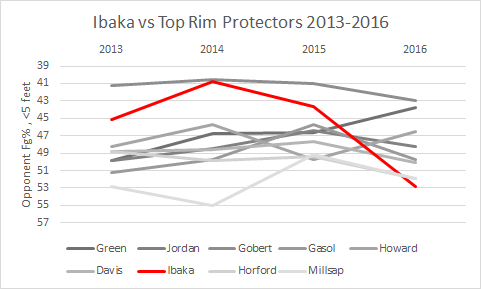After Toronto’s acquisition of Serge Ibaka last Tuesday, the reaction was generally positive. While many acknowledged the relatively low price of Terrence Ross and a mid-20’s first round pick, the trade was still not a slam dunk for one reason: Serge Ibaka is no longer elite. On Zach Lowe‘s podcast, he made it clear that Ibaka has been declining defensively for several years. For his part, Tom Haberstroh scoffed at the notion that he should care all too much about a trade surrounding a non-elite player.
Looking at Ibaka’s year to year stats, one can’t help but identify a clear peak. From 2012 to 2014, he amassed three First team all-defensive awards, achieved number 1 in blocks every year, and appeared in the NBA Finals once. In particular, His blocks per 100 possessions paints a worrying trend:
- 2011: 6.9
- 2012: 5.0
- 2013: 4.1
- 2014: 3.7
- 2015: 2.9
- 2016: 2.6
While this statistic is a very strong knock against the man known as “I-block-a,” blocks alone do not tell the whole story. As the power forward’s game has shifted towards the three point line on the offensive end, the league has been doing the same. Tasked with covering more perimeter oriented players, Ibaka has naturally had less opportunities for blocks. Therefore, it is more prudent to see how well players actually keep the ball of of the hoop when given the chance. Consider the following graph, featuring 9 of the best shot blockers in the past 4 years:

Using SportsVU stats from nba.com, players are compared using opponent field goal percentage within 5 feet of the rim on a shot that they contest. The axis is reversed, leaving the best rim protectors, also known as “Goberts,” at the top. If you select for only Ibaka, you can see that the decline of the past four years is greatly exaggerated:

Second only to the “Stifle Tower” from 2013 to 2015, only this year has Ibaka seen a precipitous fall in his percentages. There are many factors at play here, the most significant of which being the complete change in teams, systems, and teammates. Rumours have come out in the past week detailing Ibaka’s inability to fit in with the Magic. After all, who can blame him for not trying even 90% on a team going nowhere?
Interestingly, while the eye test may be saying that Ibaka’s calf injury in 2013 robbed him of his agility, it is possible that in 2014 he was once again the top of the class. The same cannot be said for two recent Raptor targets, Al Horford and Paul Millsap:

Having never reached the same defensive levels as Ibaka, these two former Hawks teammates are nevertheless applauded for “consistency” even while having a very similar season to the new Raptor’s “down” season. While there are other factors at play including ability to switch onto smaller players, there is nothing that suggests that they would have been better fits on the current Raptors lineup. Especially considering their ages of 30 and 31, there is no doubt that Ibaka can make at least an equivalent impact with the Raptors, if not greater.
All in all, the Raptor’s acquisition of Ibaka has to be seen as a huge win for the team. Not only do they acquire one of the league’s premier rim protectors, but they also did so at a fraction of the cost due to his perceived decline. I am confident that the Raptor’s gamble will pay off as Serge Ibaka is not just a great player, but an elite one still in his prime.
